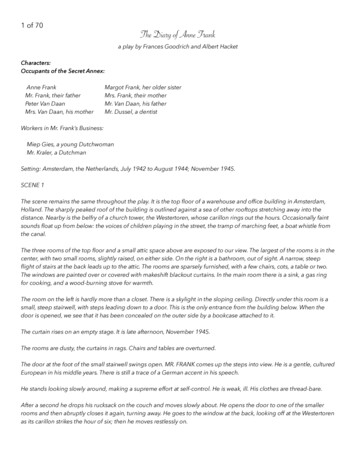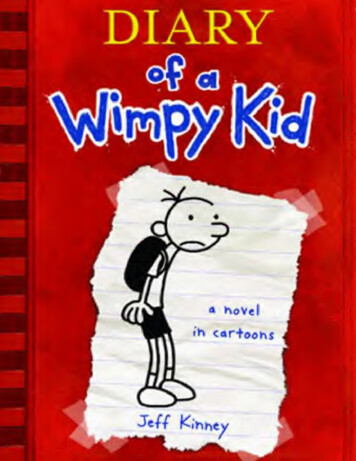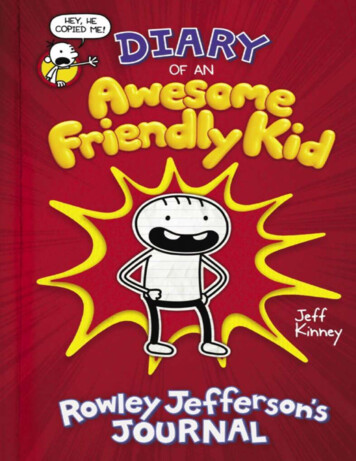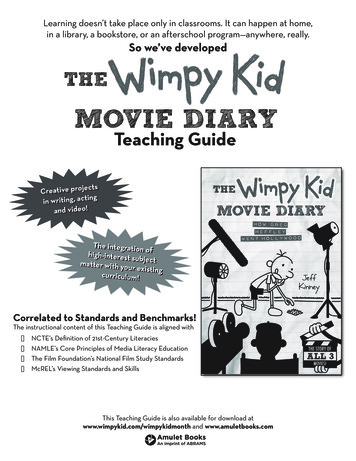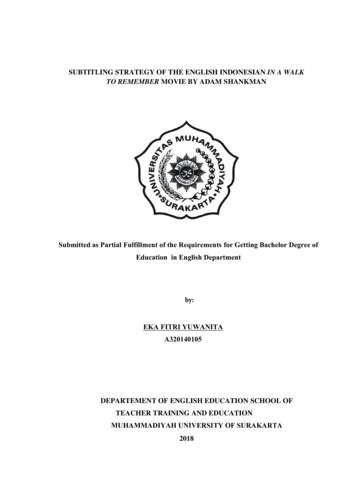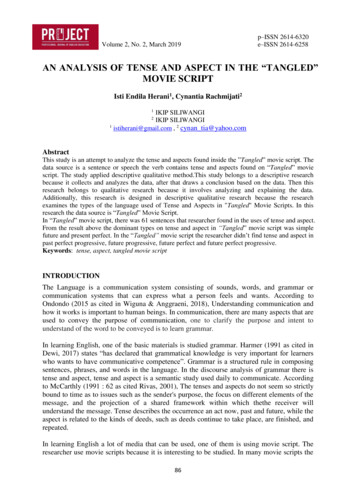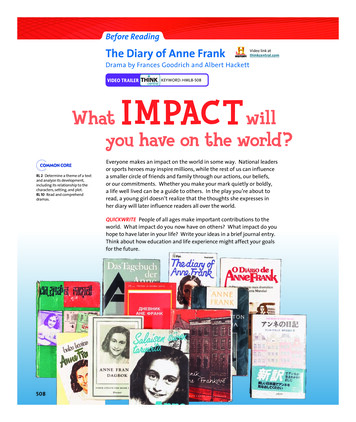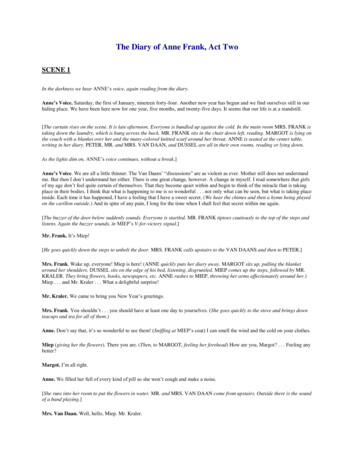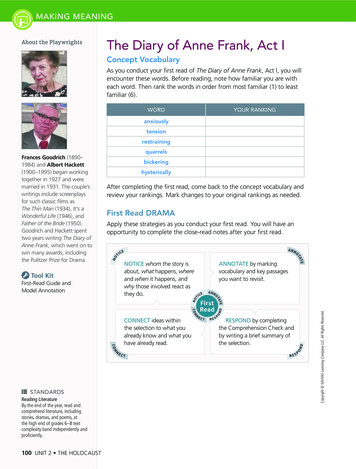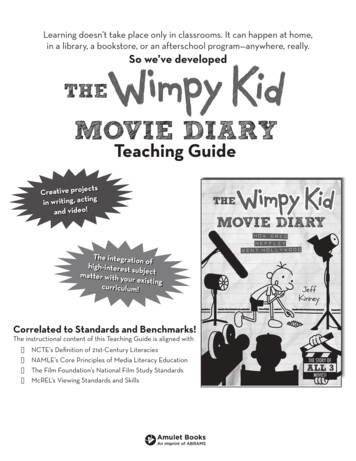
Transcription
Learning doesn’t take place only in classrooms. It can happen at home,in a library, a bookstore, or an afterschool program—anywhere, really.So we’ve developedTHEMOVIE DIARYTeaching Guidetsjecctsrojetivvee pproCreaatiCretinnggtinngg,, aacctiritiwriinin wideeoo!!aanndd vvidTThhee ininteteggraratitioonn ooffhhigighh-i-inntetererestst susubbjejeccttmmaatttteerr wwitithh yyoouurr eexxisistitinnggccuurrrricicuululumm!!Correlated to Standards and Benchmarks!The instructional content of this Teaching Guide is aligned with NCTE’s Definition of 21st-Century LiteraciesNAMLE’s Core Principles of Media Literacy EducationThe Film Foundation’s National Film Study StandardsMcREL’s Viewing Standards and Skills
Discussion GuideUse the exercises below to recall and reflect upon the wealth of information and ideas in TheWimpy Kid Movie Diary. Although some students may have already seen these movies, doing so isby no means a prerequisite for joining the conversation. The questions themselves are organizedin ascending order according to Bloom’s Taxonomy—although you’ll notice that its highest level,Creating, is covered in the activities in the following pages.RememberingActivate Prior Knowledge: To kick things off, consider having volunteers provide background onthe Diary of a Wimpy Kid books by recounting key story elements such as its plot, setting, and maincharacters. Then follow up by having them “narrate” the movie stills that appear throughout TheWimpy Kid Movie Diary, such as those in the “Page to Screen” section. (p. 152, 224, 242)Identify: What changes, additions, or deletions were made in adapting the Wimpy Kid books? Whatwere the reasons? For example, why was the Sweetheart Dance created, why was the scene of Gregchasing the kindergartners replaced, why did the filmmakers decide to set the first scene of Diary ofa Wimpy Kid: Rodrick Rules in a roller rink, and why did they seemingly skip over The Last Straw andgo straight to Dog Days for the third film? (p. 110, p. 128, 198–199, 216–217)Recall: Who are Zach Gordon, Thor Freudenthal, and David Bowers, and what were theircontributions to the films? (pp. 14, 18, 197, and throughout) Why did it make sense to cast twins forthe role of Manny? (pp. 36–37) How did the filmmakers get them to cooperate during the schoolplay scene? (pp. 108–109) Name events and conditions that needed to be “faked” during the movies’production. (e.g., pp. 122-124, 126-131, 208-209, 231, 236-237)UnderstandingClarify: What’s the difference between film andvideo, or a film camera and a video camera? (p. 117)Practice Visual Literacy: What aspects of theimages of Fregley’s home on pages 140–141 mightmake viewers share Greg’s discomfort? (Promptstudents to note props, lighting, and set design.)Describe: Creating effective movie illusions oftenrequires more than a single filmmaking element.Select an example, such as the “fake snow” or “fakeants” or one of the action scenes with the boys, anddescribe how props, special equipment, and actingwork together to create movie magic. (p. 127, 241, pp.202–203)Connect: Think about the crucial job of the film editor. (pp. 174-177) How is it like or unlike otherforms of editing that you know?2
ApplyingDistinguish: Review the role of storyboards in making a movie.(pp. 45, 100, 184) Then have students compare them to comics,citing both how they’re similar (they tell stories in a series ofsequential panels) and how they’re different (storyboards includearrows to indicate movement and don’t include word balloons).Share: Select one or more aspects of the filmmaking processdiscussed in the book (casting, story adaptation, set design)and invite students to share their opinions about them in termsof other movie adaptations with which they’re familiar. Whatcreative choices make more sense to them now that they’ve read The Wimpy Kid Movie Diary?What choices are now more puzzling?Interpret/Apply: The importance of an authentic-looking and true-to-the-book set is a major themein The Wimpy Kid Movie Diary. (pp. 26–27, 52–71, 132–141, 162-169, 198, 204–207, 226–229) Havestudents examine its many photos, perhaps in conjunction with revisiting the original descriptive textfrom the book series, and interpret the items shown, determining why they were included. Whatother details would they add to the school or the characters’ homes? Encourage students to thinklike a “location scout” by identifying spaces in their own school or community that would be a goodfit for filming a Diary of a Wimpy Kid movie or any other fictional text suitable for screen adaptation.AnalyzingCategorize: How is this book different from other titles in the Wimpy Kid series? Help studentsgrasp the fact that, though the books share a first-person “diary” format, The Wimpy Kid Movie Diaryis an example of nonfiction. Therefore, in addition to cartoon-style drawings, it also features photosand other graphics that document real-world people, places, and things.Draw Conclusion: What does the author mean by stating that the filmmakers got to “lower theirstandards” by making the “It’s Awesome to Be Me” video? And did they really lower their standards,or did they just apply their skills in a different way? (pp. 116–117)Decide: Review with students the movie credits that appear on pages248–249. Then ask students which job they’d most like to have, eitherin the case of this particular movie or as part of an ongoing career, andask them to explain why. If faced with a lack of variety in the responses,consider having students rank their first three choices, so that as a groupyou can discuss general trends, such as which jobs are the most or leastpopular. Revisit job descriptions such as those for line producer (p. 44),editor (pp. 174–177) Foley artist (p. 178), and animator (pp. 180–183) asneeded.Extend: You can both extend learning and activate prior knowledge byasking students what other movie jobs they’re familiar with. Screen a“closing credits” sequence for students or reproduce a “cast and crew”page from the Internet Movie Database (www.imdb.com), definingterms as necessary. For example, you could explain that a “gaffer” is anelectrician and that a “key grip” is in charge of moving camera tracksand other important equipment. Ask students how people in such positions might interact with setdesigners, cinematographers, and others.3
EvaluatingConsider: Explore the concept of characterizationby discussing the search for an actor to play Greg,as recounted on page 16. Do characters always needto be likable? What happens if a character is “toonice”—does the movie run the risk of not appealing toa certain audience segment?Reflect: What part of making movies is the most challenging? Rewarding? Frustrating? Be sure topoint out that while of course there are no “right answers” to such questions, students should stillsupport their responses with specific evidence from the book.6"1'-6"1'-0"2'-10 3/4"4'-11 1/4"SIDE VIEWScale: 1/2" 1'-0"8'-7 1/4"5'-5"5"1'-2 1/4" 4"2"2"2'-10 3/4"10'-1 1/2"23FRONT VIEWScale: 1/2" 1'-0"3'-8"5'-3 1/2"Scale: 1/2" 1'-0"42'-6"PLAN VIEW2'-10 3/4"11'-8 1/4"6'-4"BACK VIEWScale: 1/2" 1'-0"Debate: Aside from excitement, what are some feelings Jeff Kinney might have experienced whenHollywood initially expressed interest in Diary of a Wimpy Kid? To fuel discussion, review thevarious ideas for the movie that are presented on page 8. Use Kinney’s case as a springboard todebate the pros and cons of cinematic adaptation in general. What decisions might anger fans orcreators of the source material? If you were an author, would you be open to giving total creativecontrol to others if that was a requirement for your book becoming a movie?Practice Critical Thinking: Challenge students to voice an opinion about the test-screeningprocess. (pp. 184–185) Does getting feedback in this way alter the process or purpose offilmmaking—making it less artful, for example? Or is test screening just a way of getting valuableinput for movies, which, after all, are always developed with an audience in mind? Who do youthink is usually invited to test screenings, and what is the “target audience” for Diary of a WimpyKid and its sequels?Decide: Explore the page-to-screen process with a reminder that Dog Days was based upon partsof books 3 and 4 (p. 216). What storylines of later books might be combined into a single movie?Make sure students identify the area of overlap—is it theme, setting, or something else?4
Awesome ActivitiesReinforce and apply learning through these group-based and independent projects.Casting CallConnect writing in the “response to literature”mode to the performing arts and students’newfound knowledge of the movie-makingprocess. Create your own casting call ads usingthe model provided on page 17, which is a formof character profile, or, better yet, have studentscompose them. These can serve as benchmarksfor assessing auditions. (pp. 16–18) Students canwrite their own monologues, choose a passagefrom one of the Wimpy Kid books, or work inpairs, auditioning with a scene of dialogue instead.You can act as the casting director—or studentscan do this themselves, voting on those who aren’tin direct competition with them. To prepare forthis activity, or as an alternate form of assessment,have students write essays about their charactersjust as the film actors did. (pp. 24–25)Glossing It OverThe Wimpy Kid Movie Diary contains many “content area” vocabulary words that are specific tofilmmaking, media, and the arts. Students should be familiar with many of them, but since othersare not defined in the text, you can create a “Glossary of Filmmaking” by working as a group. Havestudents identify the words that deserve entries, or assign them yourself using the following asexamples: live-action score exec/executive special effects crane shot studio choreographer footageREBOOT MEAs new books are published and new fans discover the series, it’s conceivable that a reboot ofthe film franchise will one day be produced. Have students draw upon their outside-of-schoolknowledge and their media literacy skills to propose what this should look like. Who should staror direct? Should the tone or approach be different? Why?5
Table ReadEnhance your creative writing unit by having students conduct a table read (p. 32) as part of therevision stage of the writing process. Peer actors can be assigned parts, including “narrator,” andread aloud from prose compositions, original dramatic scenes, or skits. Or use this table read inconjunction with the “You’re the Screen Writer” activity on pages 10 and 12 of this Guide.A “Living” TrailerAs The Wimpy Kid Movie Diary shows, writing, preparing for, and shooting a film or video—evena short one—can be a lot of work, often more than is feasible in most educational settings.However, you can get students to work with many of the same creative elements—casting, scriptdevelopment, props, set design, staging, and music—in the form of a trailer. In fact, you don’t evenneed to make a video trailer. Instead, guide students to put on a live performance that runs onlya couple of minutes; a visible narrator can deliver the text one usually hears in voice-over whileother students act out the dramatic parts or supply sound effects. The subject of the trailer canbe a book that students wish were made into a movie, an imagined sequel to an existing movie,or their own creative writing. Regardless of the basis for their trailers, make sure they approachthe project from a media-literate perspective by considering their target audience, grabbing itsattention, using persuasive language, and so on.6
Poster WorkshopCombine media literacy with some graphic arts funby having students design original movie posters.This potentially cross-curricular activity can takejust a few minutes or considerably longer, dependingon the size of the poster and the extent to whichstudents revise it with visual details and multipledrafts. It’s your choice. You can emphasize a basicdesign that demonstrates understanding of moviemarketing techniques, or a finished product suitable fordisplaying in the classroom or other public area.Introduce the Concept. Revisit the text onpages 186–187 and stimulate critical thinkingwith questions such as: What posters have actually made you want to see amovie? Why? Why do you think the poster shown was revisedfrom the first version to the second? What features make a movie poster effective? Are thesedifferent from other types of posters or advertisements? How do posters grab a consumer’s attention?Identify Key Elements. A central image is critical—that’s what people see first,before they read any text. A catchy tagline delivers a quick, memorable idea. Point outhow the final poster for Diary of a Wimpy Kid is a playfulvariation on a catchphrase from the book that fans wouldinstantly recognize. Main credits are usually provided at the bottomof every one-sheet. When adding credits to theirposters, have students call out important informationonly, such as the studio, director, and the stars.Create the Poster! First, help students choose a movie—rather than a familiar one, encourage creativity by havingthem select an upcoming release or even a wholly imaginedfilm. Then, students can work individually, with partners,or in small groups to plan and sketch their posters beforeworking on the final product. Remind them to include thekey elements discussed above, and, if the film is based upona popular book or other property, to highlight this fact.7
Sequel-ManiaNew Movies, New FacesMovie sequels usually mean seeing new faces up on the screen. In fact, casting decisions aboutupcoming sequels are often hotly discussed issues among fans—who will play the new villain orthe new love interest? Use this engaging topic as a springboard for a more far-ranging explorationof both acting and casting and how the two are distinct. The latter must of course take intoaccount a given performer’s skill at the former, but also consider factors such as physicalresemblance, as well as the box office ‘bankability’ of a particular actor.Think of a popular movie that as yet has no sequel (if that’s possible!). Or use a hypotheticalscreen adaptation of a TV series or novel—even a book drawn from your class reading. Then listthe main characters on the board and have students nominate and then vote on actors to fillthese roles. Help them understand that casting directors and producers often try to create abalance of veteran “name” actors and talented newcomers.If selecting a sequel that all students can easily discuss is too challenging, consider using a“reboot” instead. For example, if the Harry Potter series were to start again from scratch withyounger actors, who would be a good fit for playing its trio of main characters? Or what stars ofstage or screen should become the latest incarnation of a famous comic book character? Why?Encourage students to cite evidence, such as an actor’s past performance in a similar role.What Matters Most?Movie fans enjoy few things as much as debating the merits of the many sequels that arereleased each year. However, rarely do they engage in in-depth conversations about the criteriathey use for judging these sequels against the original films. You can encourage higher-orderanalytical thinking and meta-cognition about media by having students prioritize the filmmakingelements on which they base such evaluations.First, create a T-chart with headings for two installments in a successful film franchise (e.g., Diaryof a Wimpy Kid, Spider-Man). Under each film, list the elements that a class consensus identifiesas it “winning” relative to the other film—acting, set design, action, costumes, humor, music,camerawork, visual effects, and so on. Then challenge students to explain why some elementsseem to count more than others when evaluating the films overall. If time permits, considerhaving students, either individually or collectively, assign a weighted point value for each of theseitems, which can be revisited when comparing any two films in the future.8
Order ItAssess understanding of the creative and technical processes outlined in The Wimpy Kid MovieDiary by having students sequence the steps presented in the book. Simply make photocopiesof this page and cut out the filmmaking tasks or events below (which are presented in theircorrect order). Then have students work in pairs or small groups to order them. If they believethat some steps can be done concurrently, they can place them side by side—but they should beprepared to explain why. If you wish, you can make the activity more competitive by providinga time limit, and you can make it more challenging by providing additional tasks mentioned inthe book. For extra credit, have students group the items into the categories of pre-production,production, and post-production.Select Bookfor AdaptationCraft ServicesProvides SnacksPitch Ideasfor ScreenplayThe Movie WrapsDraftScreenplayEdit FilmAuditionLeading ActorsTest ScreeningBuild Sets,Create PropsMovie Premiere9
USING THE REPRODUCIBLE PAGESPages 11 and 12 of this guide are student worksheetsthat you can copy and distribute; they can be used asassessment or as part of direct instruction.Who Does What?Understanding collaboration is at the heart ofunderstanding filmmaking itself. To reteach orreview various key jobs in the process, reproduceand distribute the matching-style activity on page 11of this Teaching Guide.Answer Key: 1E; 2G; 3B; 4A; 5F; 6I; 7D; 8H; 9C; 10JYou’re the ScreenwriterReproduce and distribute the annotated screenplay on page 12 of this Teaching Guide. Drawattention to screenwriting conventions such as using all caps to introduce characters anddescribe shots, or using abbreviations such as “SUPER” for “superimpose.” You can use thisprofessional model from page 11 of The Wimpy Kid Movie Diary, as well as the one on page 13,to introduce screenwriting in a general way, or as exemplars for student writing. If the latter,have them write a single script page as well. Suggested prompts: rewrite this opening scene;write the continuation of this scene; flesh out the scene described in the cartoon below; writean opening scene for an original movie idea or one based on a favorite book.10
11DateA. Creates “wireframe” version of a drawingB. “Doubles” for a lead actor in some scenesC. Creates the “world” of the filmD. Runs the audition processE. Helps keep young stars preparedF. Is in charge of the shooting schedule detailsG. Decides on a filmmaking style for a movieH. Writes a film’s scoreI. Creates a wardrobe to match each characterJ. Walks through the background of a scene1. Acting Coach2. Director3. Stunt Person4. Animator5. Line Producer6. Costume Designer7. Casting Director8. Composer9. Set Designer10. ExtraDraw a line to connect each filmmaking job with its correct description and an image that illustrates it.Who Does What?Name
NameDateModel Script PageEach scene starts with a “slugline”that states where it takes place.What do you think “INT.” means?INT. GREG’S BEDROOM 1BLACK SCREEN. Soft breathing.SUPER: “SEPTEMBER” is scrawled across the screenin Greg’s handwriting. Then BLINDING LIGHT.Stands for “point-of-view.”RODRICK (O.S.)Greg.GREG’S POV: we find RODRICK HEFFLEY, aninsolent sixteen-year-old, in our face.Rodrick is dressed for school.“Line directions” alwaysaccompany the dialogue.This means “off-screen.”Another good term to knowis “VO,” for voice-over.How will what the audience hasseen so far make it feel?RODRICK (CONT’D)Greg!GREG(half asleep)What?Rodrick shakes GREG HEFFLEY, 12, awake in his twin bed.Stage directions are alwaysset off from the dialogue.Movies try to establish charactersquickly. If this were the first timeyou encountered these characters,what would your impression ofthem be so far?RODRICKWhat are you doing? Getup! Mom and dad have beencalling you for an hour.You’re gonna be late foryour first day of middleschool.GREGWhat?Greg looks over at his clock. It reads 8:01AM12It’s okay to spell words the wayyou want actors to pronouncethem. What might be anotherexample of this?
Differentiated InstructionWherever possible, use the numerous visuals in the book to scaffold comprehension, but don’tassume that students will always “get” the main idea in the Jeff Kinney cartoons, which canrequire that readers draw upon specific background knowledge to draw conclusions or makeinferences. Also, take time to go over graphics that include text that might be small or difficultto read. (pp. 3–5) Support students who may find all the subject-specific vocabulary challengingby reminding them to use a word’s more common definition as a clue to its meaning in thecontext of filmmaking. Such words include “extra” (p. 96), “frame” (p. 98), “double” (p. 118),“composite” (p. 123), “dailies” (p. 150), and “take” (pp. 154–155).English Language LearnersThe Wimpy Kid Movie Diary is written in an accessible, almost conversational style that moststudents will find inviting. However, you may need to help ELLs with the resulting idioms, whichinclude: “pitch” (p. 10), “over the edge” (p. 110), “shot down” (p. 111), “break-dances” (p. 117),“over-the-top” (p. 118), “strike a deal” (p. 132), “wrap/wrapped” (p. 170), “cut loose” (p. 171), andmany more. You may also want to foster oral language development by presenting the textlessstills that appear on pages 190–195 and having students describe what they depict.Advanced StudentsProvide enrichment opportunities that leverage these students’ increased knowledge of thefilmmaking process. Examples include taking on leadership roles in the many projects suggestedin this Guide or writing critical pieces about specific movies that analyze their strengths andweaknesses according to the creative variables outlined in the book. You might even want tohelp these students create a weekly or monthly podcast that includes spoken reviews ofcurrent releases.13
Extension IdeasRadio DramaBuild upon the book’s section on Foley art (p. 178) by having students script, perform, andproduce old-style radio dramas, the kind in which sound effects play a significant role. Free andeasy-to-use software, such as Audacity, can make the editing process painless and fun.Cross-Curricular CollaborationsWork with a drama, visual arts, shop, or science teacher on the production of a short video. Whilestudents can work on the script under your guidance, other educators can inspire students to beas creative as the propmaster in the Diary of a Wimpy Kid movie. (pp. 142–147, 207)ContestsStimulate creativity and enhance media literacy by having groups or individuals tackle thefollowing projects:Stage a “deleted scene.” Screen DVD examples of extended/deleted scenes, and then invitestudents to script, rehearse, and perform original scenes that could have conceivably beenpart of a major Hollywood film.Transform the real world into a set. Using the details in The Wimpy Kid Movie Diary asmodels, students can construct their own sets from the Diary of a Wimpy Kid series or fromother books. The sets students create can be used for a performance piece, a party, or tocelebrate a particular holiday or occasion.Hold a “pitch fest.” Enhance writing and speaking skills by having students work in teamsto pitch you, or a panel of “executives” made up of other adults, a movie idea. Encouragethem to use persuasive language but also to include plenty of specifics, drawing upon theirknowledge of how movies are produced and marketed.Journal WritingHave students keep a “diary” that traces the history of a collaborative project much like JeffKinney does in his book. The topic can be a school play, a research/science project, a communityservice project, or even a trip. Provide guidelines and coach students to use the writing skills theyhave developed in terms of expository, anecdotal, and autobiographical texts.Further Resources The Core Principles of Media Literacy: https://namle.net/publications/core-principles/ The educational projects of The Film Foundation: http://www.film-foundation.org Two middle-grade programs that teach movies and media literacy: Holt McDougal’s MediaSmart and Pearson Education’s Media Studio.Conceived and written by Peter Gutiérrez, a media literacy Spokesperson for the National Council of Teachers ofEnglish (NCTE) and a former board member of the National Association for Media Literacy (NAMLE). His professionaldevelopment book The Power of Scriptwriting! is available from Teachers College Press.Diary of a Wimpy Kid motion picture elements copyright 2010, 2011, 2012 Twentieth Century Fox Film Corporation. All rights reserved.The Wimpy Kid Movie Diary (excluding motion picture elements) copyright 2010, 2011, 2012 Wimpy Kid, Inc. DIARY OF A WIMPY KID ,WIMPY KID , and the Greg Heffley design are trademarks of Wimpy Kid, Inc. All rights reserved.
Wimpy Kid Movie Diary. Although some students may have already seen these movies, doing so is . why did the filmmakers decide to set the first scene of Diary of a Wimpy Kid: Rodrick Rules in a roller . The importance of an authentic-looking and true-to-the-book set is a major theme
